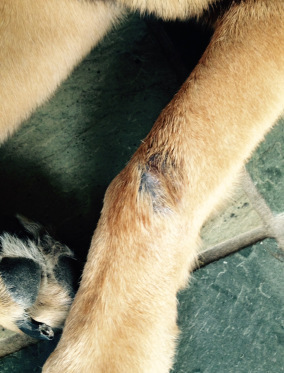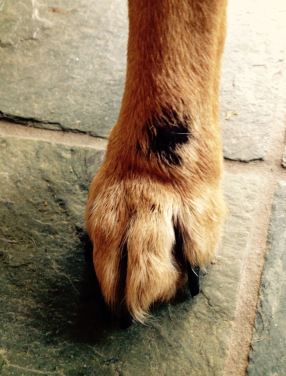Curing Magic Markers: Acral Lick Granulomas & What to Do
Curing Magic Markers: Acral Lick Granulomas & What to Do

When your pet is so itchy he licks sores onto his legs, what’s a caring pet owner to do? Image Copr. DepositPhotos.com/Quasarphoto
Magic has been miserable, chewing and scratching himself nearly 24/7 for the past two months. We attributed all the itch-icity to bug bites, although he’s on a monthly flea preventative.
Then we noticed he’d begun lick-lick-licking his left “wrist” until the fur wore off, and skin turned raw. Again, we figured he’d had a bug bite or other minor irritation that caused the problem. By keeping it clean and interrupting his licking, the spot healed and fur began to re-grow.

Thick sticky tears from weepy eyes that’s hard to clean away–hair loss around his eyes. The vet suspected “dry eye.” Yikes!
About the same time, his eyes began to water more than usual. This happened right after one of his games of “hose tag” so we figured he’d just had a bit of water irritation. But even as the front leg healed, he began licking the toes on a rear foot, again self-barbering away fur and leaving the area raw. On top of that, the front “wrist” area looked thickened like a large callus even with most fur back in place. The outside base of one ear became sore and itchy.
FLEAS? ATOPY? ACRAL LICK SORES? AUTOIMMUNE DISEASE?!
Now, after writing about many different doggy ailments over the years, I always fear the worst. Our first German Shepherd had such devastating skin disease that at one time, he became nearly bald with itchy sores all over his ears and body, and his skin turned black from saliva stains. He had to eat a homemade diet, be bathed twice a week, and take 14 pills of various kinds every day. He only returned to near-normal when we moved to Texas but was never fully healthy.

Magic’s left front “wrist” with saliva-stained thickened skin–but at least the fur has begun to return and it’s no longer raw.

Magic’s left rear paw–he licks the top of the toes, too, but fur has covered that portion up. The dark place is stained hairless tissue–it’s healed, but was bright red and raw.
Magic has always been extraordinarily healthy, so it came as a shock to see some of the same signs that our first dog had suffered. I suspected it could be a couple of things—lick sores are common in German Shepherds—but worried it might even be an autoimmune issue (way scary!). Guessing gets nothing done, and it takes a professional to figure things out. Last week, we took him to the veterinarian to find out what was going on, and how to keep him comfortable.
Now, Magic LOVES the vet—licks all over his face!—but he’s a big dog and won’t allow certain handling. While the veterinarian echoed some of my initial suspicions, a definitive diagnosis required tests in order to prescribe the right meds. So we agreed to leave him for sedation so a skin scrapping of the sores, an ear culture, and a tear test could be done.
MAGIC’S DIAGNOSIS
The good news—it is NOT an autoimmune issue. Whew! More good news—Magic’s tear test was normal, so we’re not dealing with dry eye. While it’s not common, the vet suspected teary eyes were a result of allergies.
More good news—no ear flushing was needed, the inflammation was isolated to the external base of the front of the ear. Again, this was attributed to allergies (probably atopic dermatitis). While in the past, atopy has been defined as “inhalant” allergic dermatitis, today it’s considered more of a contact allergy with paw-pad exposure and absorption of allergens being a big influence. Wow…knowing that could have helped our first dog enormously!
On to the spots on Magic’s paw and leg—and yep, they were diagnosed as lick sores, technically called acral lick granulomas. The skin scraping indicated bacteria was present, too. There are LOTS of causes, from an initial irritation to stress, boredom, and even obsessive-compulsive issues.
WHAT IS ACRAL LICK GRANULOMA?
With acral lick granulomas, the dog incessantly licks a selected area, usually on a lower leg, which creates a raised, hairless ulcerative plaque—almost a callus that surrounds the never-healing sore. The constant licking makes the area itch and can cause secondary bacterial infection. This prompts further licking to relieve the itch, and a vicious cycle is created.
Any dog can be affected, but the condition most commonly affects males older than three years. The syndrome is often seen in large active-breed dogs that demand a lot of owner interaction, such as Golden Retrievers, Labrador Retrievers, Doberman Pinchers, Great Danes, and you guessed it—German Shepherds.
Treatment is difficult in many cases, and some dogs may never be completely cured. Infections may respond to antibiotics, and steroids may temporarily soothe itchiness.
MAGIC’S Rx
Magic was given cephalexin antibiotic, Betagen topical spray for the sores, and low dose prednisolone to calm the whole body itch. The veterinarian says he’ll need to be on the antibiotic for at least two months (probably longer) until both lesions completely heal since often these are deep seated infections—and they could recur down the road. The steroid is low-dose and will be gradually reduced.
The night Magic came home he was still woozy from the sedation. But by the next day and just one round of medication, he already felt so much better! We’re now about five days into the treatment, and with the itchiness calmed, both leg sores have made great progress toward healing, and his eyes no longer water incessantly.
GENERAL RECOMMENDATIONS
In many cases, giving dogs stricken with lick sores more one-on-one time can help reduce boredom and stress. Since I work at home, Magic has attention pretty much all the time, but there has been quite a lot of stress over the past several months due to job changes. Dogs can react to an owner’s stress—so I need to work on handling my own angst-icity!
Dogs that are confined alone for long periods of time tend to have more problems. Some dogs respond favorably when another pet is adopted into the home. Magic has Karma—the jury is out on whether that’s helpful or added stress! The habit may be interrupted in some dogs through the use of veterinary prescribed drugs used in treating obsessive/compulsive disorders. All that, of course, is up to the veterinarian and based on the individual dog’s situation.
Have you ever had a dog that suffered with “lick sores?” How did you manage it? Were the lesions healed, and were there any relapses? What else should I watch for with Magical-Dawg?
I love hearing from you, so please share comments and questions. Do you have an ASK AMY question you’d like answered–post in the comments. Stay up to date on all the latest just subscribe the blog, “like” me on Facebook, and sign up for Pet Peeves newsletter. Stay up to date with the latest book give aways, kewl product offers, and appearances related to my THRILLERS WITH BITE!
AMY SHOJAI'S Bling, Bitches & Blood - Pet-centric Writer-icity & Thrillers With BITE!
 newest »
newest »





So.... food for thought? Would Kongs work to help interrupt some of this pattern of licking?